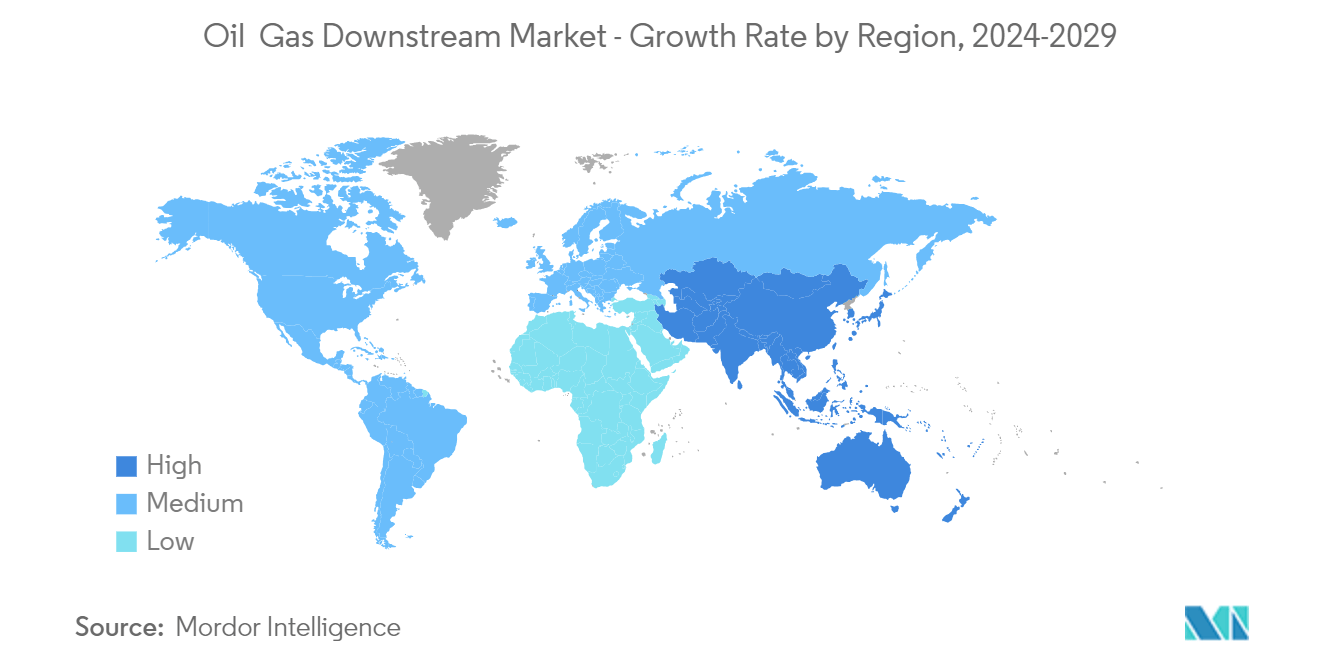Market Trends of Oil & Gas Downstream Industry
Refineries to Dominate the Market
- Downstream activities involve refining petroleum crude oil, processing and purifying raw natural gas, and marketing and distributing products derived from crude oil and natural gas.
- The global crude oil refining sector has witnessed significant growth due to increasing demand for refined products from the transportation sector. Higher margins have propelled the crack spread, a crucial factor for oil refiners' profitability, and encouraged investment in new projects. Earlier, North America had been the major for the downstream sector. However, the growing population, urbanization, and industrialization in the East have increased the demand for refined products, leading to the focus of investments shifting toward China, India, and other Southeast Asian countries.
- In 2020, the downstream market industry was significantly affected by the COVID-19 pandemic and low demand for oil products. However, relaxation in COVID-19-related restrictions and rising demand for oil & gas products from the key economies resulted in higher margins in the downstream segment. In 2022, due to the Russian-Ukrainian war, there was a surge in oil prices and a deficit in crude oil supply, especially from Russia. Europe, a significant importer of crude oil from Russia, faced a shortage in crude oil supply in its refineries. Moreover, Europe was a major importer of petroleum products from Russia. However, the war banned the petroleum products supply. Hence, to meet the petroleum product demand in Europe, the region can witness investment in the refining sector during the upcoming years.
- Further, the global oil refinery capacity increased to 101902 thousand barrels daily (kb/d) by 2022, from 98965 kb/d in 2017, and the refinery capacity increased by around 3% during this period.
- Few of the operators continue to upgrade or plan their expansions. For instance, in September 2022, Colombian state oil company Ecopetrol completed expansion works at its Reficar oil refinery in Cartagena as it seeks to meet rising domestic fuel demand. This expansion consolidates the Cartagena refinery as a strategic asset to guarantee Colombia's energy sovereignty. Also, this refinery would now produce diesel and gasoline with sulfur content levels below 100 parts per million (ppm) and 50 ppm, respectively.
- In December 2022, the Brazilian state-owned oil company Petrobras announced investments totaling approximately USD 9.2 billion over the period 2023-2027 to boost the production of ultra-low sulfur diesel and middle distillates across its refineries, including the company's first venture into renewable energy. A total of two-thirds of the investments in refining will be allocated to activities related to expanding production and improving quality, increasing energy efficiency, and refining biofuels.
- Hence, the refining industry is anticipated to recover over the next five years as fuel prices rise and consumption increases. Thus, the refinery industry is expected to be a significant factor in the growth of the downstream market during the forecast period.

Asia-Pacific to Dominate the Market
- According to a Statistical Review of World Energy data for 2023, Asia-Pacific accounted for almost 35.5% of the global oil refining capacity.
- As of 2022, India accounted for almost 5% of global oil refinery capacity. The growing demand for refined petroleum products has driven downstream companies to invest in new projects and expand existing facilities.
- For instance, in September 2023, the prime minister of India laid the foundation stone for Bharat Petroleum Corp Ltd's (BPCL) refinery expansion and greenfield petrochemical project in Bina. The expansion project increases BPCL's refinery capacity to 11m tonnes/year from 7.8m tonnes/year currently. A manufacturing complex will also be built to produce more than 2.2m tonnes/year of petrochemical products. The cost of this project is USD 5.9 billion.
- As of 2022, China accounted for 16.9% of global oil refining capacity. The country's petrochemical and refinery sector is expected to be positive during the forecast period.
- In March 2023, Saudi Aramco and its Chinese partners announced that they aim to start entire operations at a petrochemical and refinery project in northeast China in 2026 to meet the country's growing demand for petrochemicals and fuel. The project in Liaoning province's city of Panjin, expected to cost USD 10 billion, will be Aramco's second significant refining-petrochemical investment in China.
- Hence, the region is expected to dominate the oil & gas downstream market during the forecast period owing to the increasing investment in the refining and petrochemical sector and the expansion of existing downstream infrastructure in respective countries.


